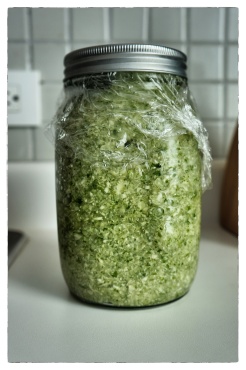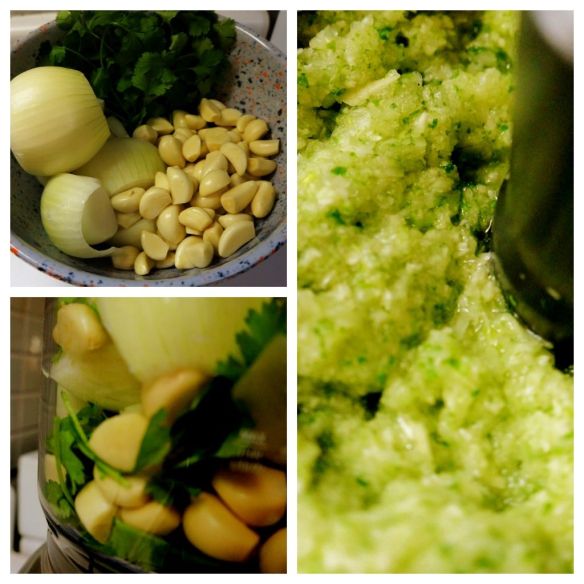If you ever ask a Puerto Rican what is the staple food over here, the reply will most likely be “Rice, beans, and _______.” The last of which will be filled with the name of some animal protein that can vary immensely. Rice and beans, however, are always constant.

When we say rice, we mean white rice, unless we specify otherwise. When we say beans, we mean beans cooked in tomato sauce; but this sauce is special not because it requires rare ingredients or complex techniques, but because it has an extraordinarily flavorful and simple base: sofrito.
I guess most cultures have their own bases. The French came up with mirepoix and I’ve heard that people in the south of the US call their base creole. Every base is comprised by different ingredients that, I suppose, are not only easy to find, but also cheap in each region. In fact, I believe that the recipe for sofrito will most likely differ from family to family, or maybe from town to town. Whatever the case, sofrito is the foundation of most Puerto Rican, and perhaps even Caribbean, dishes. We use it to flavor virtually everything and anything savory. This base is so fundamental to Puerto Rican cuisine, my grandmother makes spaghetti sauce with it – and it is delicious.
This recipe was given to me by my grandfather, and though it is extremely simple, it is packed with flavor. It is something of a miracle, really, that this recipe of just three ingredients elevates “OK” beans to “YUM! What did you put in this?” beans.
Abuelo Ismael’s Quick Sofrito
This recipe yields about about 4-1/2 cups of sofrito, but it will vary with the size of the processed goods.
Tools and Equipment
Sharp knife
Cutting board
Clean towel
Clean jar or container
Strainer – optional
Ingredients
1 lb. Garlic heads = 5 – 8 garlic heads
2 lbs. Spanish onions = about 3 – 5 onions
1/4 lb. Cilantro (or cilantrillo) = about a handful

- Peel, separate, and cut the stem ends off the garlic, exposing the cloves. Peel the onions and cut off the root ends. Cut the cilantro stems near the root. Discard all the inedible ends.
- Wash all the ingredients thoroughly, but make sure to pat them dry, at least until all the excess water is removed. I like to leave them about an hour or two over a clean towel, just to make sure they’re dry and clean.
- Cut the cilantro into 3-inch long segments and place in a food processor. Layer the garlic cloves evenly over the cilantro in the food processor. Cut the onions into an appropriate size to fit the food processor and layer over the garlic. You might have to do this by batches. I was lucky enough to borrow my mom’s huge food processor, but my grandfather makes this by batch and it works just fine. Even better, because he does it ;-). If you do make it by batches, though, make sure to split the ingredients, such as to have approximately equal amounts per batch. You don’t want to stir this much after it’s done.
- Pulse in the food processor until the desired garlic and onion size is reached. The cilantro should be processed thoroughly, though.
- Transfer sofrito to the clean container and seal as tight as possible. This can hold up for two weeks. Though the flavor changes slightly as time progresses, this is not a bad change. You can certainly freeze it, but that will mellow the flavors down considerably. I like to keep mine in the fridge for two weeks maximum. The rest, I give out as a gift. Really.
Note: If there is a lot of liquid when you process the ingredients, get a fine-mesh strainer, like those used to sift flour, for example, to remove as much of the liquid as possible. Runny sofrito goes bad faster and does not cook as well as mildly-chunky-and-not-as-wet sofrito.
How to use it. With a little amount of oil, sauté as much sofrito as you believe necessary until the onions and garlic turn golden and the smell is irresistibly delicious. Proceed with your intended recipe as usual, but this time, you have a base layer of flavors to build on. =)
Any questions? Feel free to ask.

